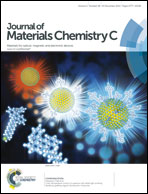Eu(iii)/Eu(ii)-doped (Ca0.7Sr0.3)CO3 phosphors with vaterite/calcite/aragonite forms as shock/temperature detectors
Abstract
A pure metastable Eu(III)-doped (Ca0.7Sr0.3)CO3 vaterite phase has been obtained by the precipitation method. After thermal treatment of this phase, the carbonate crystallizes with a calcite structure. Moreover, with the incorporation of 30 mol% of Sr that tends to stabilize the aragonite structure, both vaterite and calcite phases are able to transform easily into this high-pressure form by mechanical treatment. Hence, for this single composition, the three allotropic forms are achieved and can be compared. Photoluminescence studies indicate the stabilization of the Eu ions in the carbonates obtained, whatever the allotropic form, in the trivalent oxidation state. Significantly different luminescence properties have been found depending on the carbonate structure, which are associated with the various local environments of the doping element. This offers the possibility to employ these Eu(III)-doped samples as shock and/or temperature detectors. In addition, the use of a CaH2 reducing agent allowed reduction of the main part of the Eu(III) content into Eu(II) in the three different carbonate forms at low temperature. Photoluminescence studies were also performed in these Eu(II)-doped samples and show slightly different emission spectra for the three crystalline structures.


 Please wait while we load your content...
Please wait while we load your content...